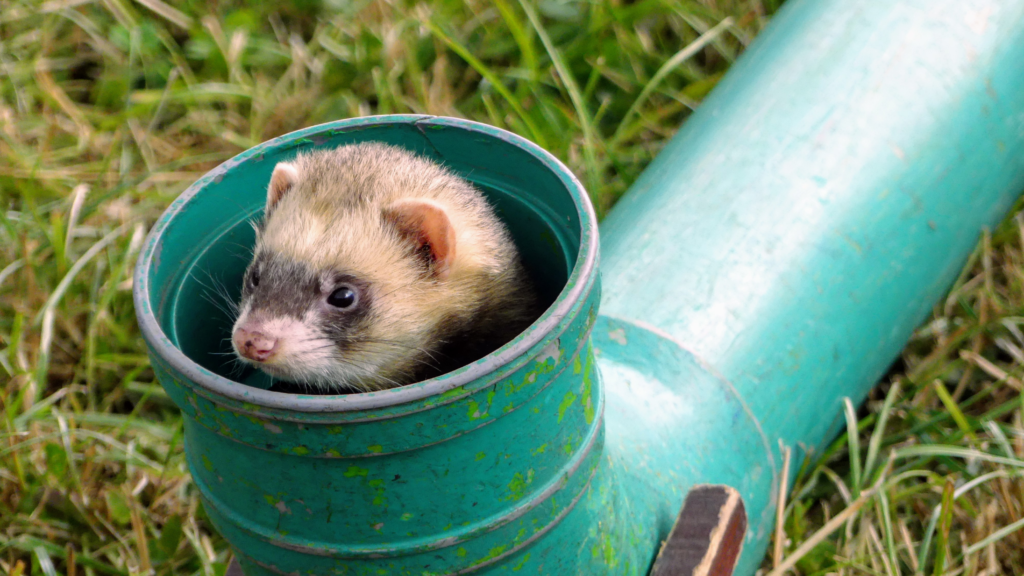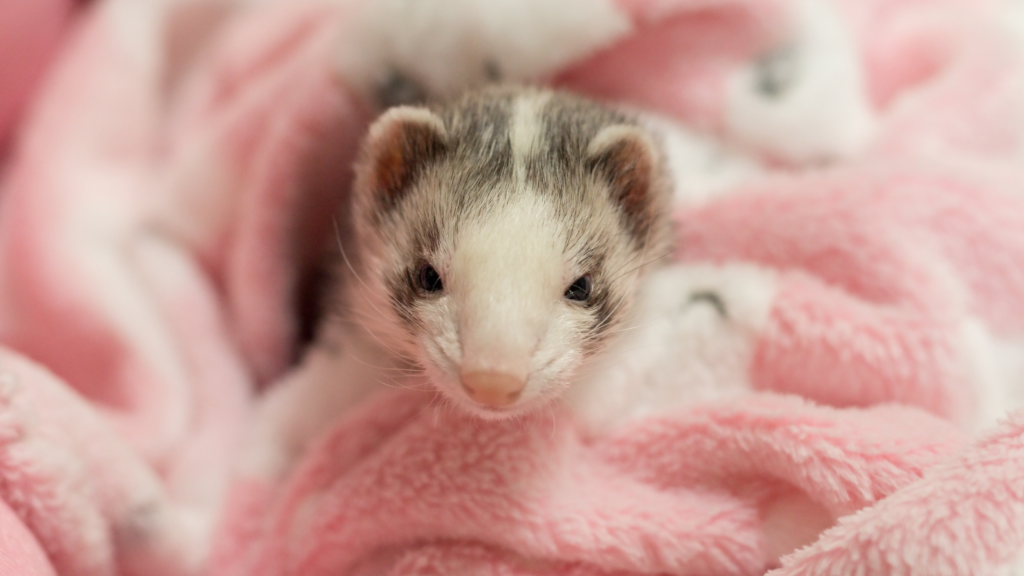Thinking about ferret adoption and care? These playful, intelligent, and affectionate creatures make fantastic pets, but they also require special attention and commitment. Before bringing one home, it’s essential to understand where to get a ferret, what to look for, and how to prepare for your new furry friend.
This comprehensive guide to ferret adoption and care will cover everything from deciding whether to adopt or buy, recognizing a healthy ferret, and preparing the perfect home for your new pet. Whether you’re a first-time owner or adding to your ferret family, this guide will help you make an informed decision and ensure a happy, healthy life for your pet.
Ferret Adoption and Care: Key Considerations Before Getting One
Ferret adoption and care require time and effort because these pets are fun, affectionate, and full of personality, but they’re not the right pet for everyone. Unlike cats or dogs, ferrets have unique needs and behaviors that require careful consideration before bringing one home. They need daily interaction, a specialized diet, and plenty of mental stimulation to stay happy and healthy. If you’re thinking about adopting a ferret, it’s essential to understand their behavior, care needs, time demands, and financial commitment to ensure you can provide the best home possible. Let’s explore the key factors that will help you decide if a ferret is the right pet for you.
Ferret Adoption and Care: Understanding Their Behavior & Needs
Ferret adoption and care require dedication because while ferrets may be small, they are far from low-maintenance pets. These lively creatures need daily playtime, enrichment activities, and a ferret-proofed environment to thrive. If you’re looking for a pet that can be left alone for long periods, a ferret may not be the best choice.
One of the most important things to know about ferrets is their mischievous and playful nature. They are incredibly intelligent and love to explore, often getting into places they shouldn’t. They enjoy digging, climbing, and stashing items—so don’t be surprised if your car keys or socks go missing! Ferrets also thrive on social interaction, both with their human family and other ferrets. Many owners find that having at least two ferrets keeps them entertained and reduces loneliness.
Daily care involves feeding a high-protein diet, cleaning their cage and litter box, and providing at least 3-4 hours of out-of-cage playtime. Unlike hamsters or guinea pigs, ferrets require constant supervision when out of their enclosure to prevent accidents. If you’re ready for a pet that is interactive, energetic, and full of surprises, a ferret might be a perfect match!
Ferret Adoption and Care: Understanding Time & Financial Commitments
Ferrets require a significant investment of time and money, and it’s crucial to be prepared for the long haul. One of the biggest mistakes new owners make is underestimating the amount of time ferrets need for socialization. These pets aren’t content sitting in a cage all day—they need several hours of playtime, interaction, and mental stimulation daily. If you have a busy schedule or travel often, a ferret may not be the best fit for your lifestyle.
Financially, ferrets aren’t cheap pets to own. While the initial cost of adoption or purchase ranges from $100 to $500, ongoing expenses add up quickly. Quality ferret food, bedding, litter, and toys can cost $40 to $100 per month. Vet care is another major expense, as ferrets require vaccinations, annual check-ups, and emergency care if health issues arise. Common medical conditions like adrenal disease and insulinoma can lead to costly treatments, sometimes exceeding $1,000 per year.
Additionally, ferrets have a lifespan of 5 to 10 years, meaning you’re committing to nearly a decade of care. Before adopting, consider whether you’re financially and emotionally ready to care for a ferret long-term. If you’re prepared for the time, effort, and financial responsibility, ferrets can be incredibly rewarding pets that bring years of joy and companionship.

Ferret Adoption and Care: Should You Adopt or Buy?
One of the first decisions in ferret adoption and care is choosing between adoption and buying, both of which have their advantages and challenges. Both options have advantages and challenges, and understanding the differences can help you make an informed decision that aligns with your lifestyle and values. Adoption offers the opportunity to give a rescued ferret a second chance, while purchasing from a breeder or pet store provides access to younger ferrets with known backgrounds. However, costs, availability, and ethical concerns should also be considered. Let’s explore the differences between adoption and buying, and weigh the pros and cons of each.
Adoption vs. Buying – What’s the Difference?
Adopting a ferret from a shelter or rescue is a compassionate choice, but it’s different from purchasing one from a pet store or breeder. When adopting, you’re usually taking in a ferret that has been surrendered due to a previous owner’s circumstances. These ferrets may be adults rather than kits (baby ferrets), and they could come with some health or behavioral history. However, many rescues provide veterinary care, vaccinations, and behavioral assessments before adoption, ensuring the ferret is healthy and ready for a new home.
Buying a ferret from a pet store or breeder means you’re more likely to get a young kit, typically between 6 and 12 weeks old. While pet stores are more accessible, they often sell ferrets that have been mass-bred, weaned too early, or poorly socialized, leading to potential health or behavioral problems. Reputable breeders, on the other hand, provide well-socialized, healthy ferrets, but their prices can be significantly higher.
Cost is another factor to consider. Adoption fees range from $50 to $150, while purchasing from a pet store or breeder can cost anywhere from $100 to $500. Additionally, first-time owners must budget for cage setup, food, bedding, toys, and veterinary care, which can add up quickly.
Common myths about adoption include the belief that adopted ferrets are always aggressive or unhealthy, which is simply not true. Many surrendered ferrets are loving and well-socialized, needing only a second chance at a stable home.
Pros and Cons of Adopting a Ferret
Adopting a ferret is rewarding but requires careful consideration. One advantage is providing a rescued ferret with a loving home. You may even save them from euthanasia or a long stay in a shelter. Many adopted ferrets are already litter trained and socialized. This makes them easier to integrate into your home than a young kit. However, some may have health or behavioral challenges.
Ferrets with past trauma may need extra patience and training. Rescues aren’t as common as dog or cat shelters, limiting availability. Finding an adoptable ferret may take more effort and time. Despite this, adoption helps ferrets in need and saves money. Many rescues spay, neuter, vaccinate, and provide medical check-ups before adoption, reducing initial veterinary costs for new owners.
Pros and Cons of Buying a Ferret
If you prefer a young ferret with a known history, purchasing from a reputable breeder or pet store may be the right choice. Breeders often provide health screenings and detailed care information, ensuring a well-socialized pet.
However, buying a ferret comes with risks, especially from pet stores that source from large-scale breeding operations. These ferrets may be weaned too early, poorly socialized, and prone to genetic health issues. Many are spayed/neutered too young, increasing the risk of adrenal disease.
Ethical concerns also play a role, as some breeders prioritize profit over animal welfare. To avoid supporting poor breeding practices, thoroughly research breeders to ensure proper medical care and ethical treatment.
Both ferret adoption and care require commitment. Adoption is a cost-effective, compassionate choice, while purchasing from a trusted breeder offers control over health history. Whichever path you choose, responsible care, love, and commitment are key to a happy, healthy ferret.
Ferrets come in various colors and coat types. Learn more in our Ferret Breeds and Colors Guide.

Ferret Adoption and Care: Best Places to Adopt or Buy
Not all sources are equal when it comes to finding a ferret, and choosing where to adopt or buy your new pet is just as important as deciding to bring one home. While pet stores offer convenience, they aren’t always the best option. Rescues provide a chance to help a ferret in need, while reputable breeders ensure you get a well-socialized, healthy ferret from the start. Understanding the differences between these sources will help you make an informed decision and ensure you bring home a ferret that fits your lifestyle and expectations.
Animal Shelters & Ferret Rescues
If you’re looking to adopt a ferret, start by checking with local animal shelters and ferret-specific rescues. Unlike pet stores, these organizations focus on rehoming abandoned or surrendered ferrets, often providing them with medical care, vaccinations, and behavioral assessments before adoption. To locate a reputable ferret rescue, search online for ferret adoption groups in your area or check national organizations like the American Ferret Association for recommendations.
The adoption process typically involves filling out an application, answering questions about your experience with ferrets, and possibly undergoing a home visit to ensure a safe environment. Adoption fees usually range from $50 to $150, which often includes vet care like spaying/neutering and vaccinations.
A key part of ferret adoption and care is understanding that rescued ferrets are often well-socialized and friendly, despite common misconceptions. Some may need extra patience, especially if they were previously neglected, but rescues often provide guidance on how to help them adjust. If you’re looking for a rewarding experience and want to give a ferret a second chance at a loving home, adoption is an excellent option.
Pet Stores – What You Need to Know
Buying a ferret from a pet store might seem like the easiest option, but there are a few important factors to consider before making this choice. While pet stores provide access to young ferrets, these animals often come from large-scale breeding facilities (similar to puppy mills), where they receive minimal socialization and early separation from their mothers. This can result in behavioral challenges and health issues down the line.
One major concern with pet store ferrets is early neutering and descenting. Many stores sell ferrets that have been spayed or neutered at just a few weeks old, which can lead to hormonal imbalances and an increased risk of adrenal disease later in life. Additionally, ferrets in pet stores are kept in small enclosures with little human interaction, making them more prone to biting, fearfulness, or difficulty adjusting to a new home.
If you do decide to buy from a pet store, ask the right questions: Where do their ferrets come from? How old are they? Have they received vet care? Choose a store that prioritizes ferret welfare over profits and ensures their animals are healthy and well-handled. However, if you have the option, consider adopting or buying from a responsible breeder or rescue instead for a healthier and better-adjusted pet.
Reputable Ferret Breeders
Buying from a reputable breeder ensures your ferret has a healthy genetic background and proper early socialization. Ethical breeders focus on responsible breeding, genetic diversity, and socialization from a young age. Unlike pet stores, they allow you to meet the ferret’s parents, inspect living conditions, and ask about their health history.
To identify a responsible breeder, look for those who prioritize health over quantity, provide medical records, and don’t separate kits too early. Avoid breeders who refuse facility visits, lack health records, or keep ferrets in poor conditions.
Some breeders specialize in Angoras or hybrid ferrets, while others focus on specific colors. If you’re looking for a particular type, researching trusted breeders is crucial.
While buying from a breeder is costlier than adoption, it gives you control over your ferret’s health, temperament, and genetics. Choose a breeder who values animal welfare over profit.
Where you get your ferret matters. Pet stores often come with health risks, while adopting from a rescue or shelter gives a ferret a second chance at a loving home.a second chance, while buying from a reputable breeder ensures you get a healthy, well-socialized pet. By carefully considering your options and choosing a source that prioritizes ferret welfare, you can start your journey as a ferret owner on the right foot!
Ferret Adoption and Care: How to Choose a Healthy Ferret
Bringing home a ferret is an exciting experience, but choosing a healthy, thriving pet is key to ensuring a long and happy life together. Proper ferret adoption and care ensure that these energetic, social animals get the best start in their new home. Whether you’re adopting from a rescue, purchasing from a breeder, or even considering a pet store ferret, it’s important to know what signs indicate good health and which red flags to avoid. Beyond physical health, temperament also plays a role in selecting the right ferret for your home. Let’s break down the essential factors to consider when choosing a healthy ferret.
Signs of a Healthy Ferret
A healthy ferret should look alert, bright-eyed, and full of energy. When evaluating a ferret, check for clear, bright eyes with no discharge, clean ears that are free from wax buildup or redness, and soft, well-groomed fur with no bald patches. Their coat should feel smooth, not greasy or overly coarse.
Behavior is another strong indicator of health. Ferrets are naturally curious and playful, so a healthy one should be active, responsive, and eager to explore when awake. They may engage in bouncing movements (often called the “weasel war dance”), playfully nip at toys, or show interest in their surroundings. While ferrets do sleep a lot—up to 18 hours a day—they should wake up alert and ready to interact.
Lastly, check the ferret’s weight and muscle tone. A healthy ferret should have a lean but strong body, with no visible ribs or excessive bloating. Their legs should be sturdy, allowing them to walk and climb with ease. If a ferret appears underweight or excessively thin, it could indicate malnutrition or an underlying health condition.
Red Flags to Watch For
While some minor issues can be treated, certain warning signs should make you think twice before bringing a ferret home. Lethargy or excessive sleepiness beyond normal ferret habits can indicate illness. If the ferret seems uninterested in playing or doesn’t respond when handled, it could be a sign of distress or poor health.
Physical symptoms like bald spots, patchy fur, or overgrown nails are also causes for concern. Hair loss may suggest adrenal disease, which is common in older ferrets and can lead to hormonal imbalances. Overgrown nails indicate poor grooming and potential neglect, which may mean the ferret hasn’t received proper care. Similarly, dirty ears with black or dark brown debris can be a sign of ear mites, which require veterinary treatment.
One of the biggest red flags is respiratory issues. If a ferret is wheezing, coughing, or has nasal discharge, it could be battling an upper respiratory infection. Also, check for signs of parasites, such as fleas or skin irritation. A thorough health check before adoption or purchase can save you from unexpected medical bills and ensure you’re bringing home a strong, happy pet.
Personality Considerations
Just like people, ferrets have unique personalities, so choosing the right match for your household is important. Some ferrets are laid-back and cuddly, while others are high-energy and always on the move. If you want a ferret that enjoys snuggling, look for one that willingly climbs into your hands or sits calmly when handled. If you prefer an energetic, playful ferret, choose one that actively explores and engages with toys.
You might also wonder: does gender affect personality? While there’s no strict rule, male ferrets (hobs) tend to be larger and sometimes lazier, while female ferrets (jills) are often smaller and more energetic. However, personality is more influenced by individual temperament than gender alone.
Before making your decision, test a ferret’s temperament by interacting with them. Try offering a toy, gently picking them up, or observing their response to new stimuli. If they show interest, playfulness, and comfort with handling, they are likely well-socialized. If they are overly fearful, aggressive, or bite hard, they may need extra training or socialization. Taking time to choose a ferret with the right personality for your lifestyle will make your experience as a ferret owner much more enjoyable!
Regular checkups are essential for your new pet. Read our Ferret Health Guide to ensure your ferret stays happy and healthy.

Preparing for Your New Ferret
Bringing home a ferret is an exciting adventure, but it requires careful preparation to ensure a smooth transition. Ferrets are curious, energetic, and intelligent, meaning they need a well-equipped living space and a safe, engaging environment. Before your new furry friend arrives, it’s essential to have the right supplies, a properly ferret-proofed home, and a plan for their first few days. By setting things up in advance, you’ll create a stress-free experience for both you and your new pet.
Essential Supplies for a New Ferret
Your ferret’s cage setup is one of the most important factors in their well-being. A crucial aspect of ferret adoption and care is providing a spacious, multi-level cage with solid flooring (avoid wire-bottom cages, as they can hurt their feet). Include soft bedding or fleece liners, a hammock or cozy sleeping pouch, and a litter box in one corner. Since ferrets are escape artists, make sure the cage has secure latches and appropriately spaced bars to prevent any unexpected breakouts.
For nutrition, provide high-quality ferret food that is high in protein and fat but low in carbohydrates. Avoid dog or cat food, as it lacks the nutrients ferrets need. Fresh water should always be available in both a bowl and a water bottle to accommodate different drinking preferences.
Toys and enrichment are essential to keep your ferret happy and stimulated. Tunnel systems, crinkle balls, and plush toys encourage play and exercise, while food puzzles keep their minds engaged. Rotate toys regularly to prevent boredom, and always supervise playtime with small objects to avoid accidental ingestion.
A well-enriched environment helps adopted ferrets adjust faster. Learn more in our Ferret Enrichment Guide.
Ferret-Proofing Your Home
Ferrets are notorious for getting into everything, so ferret-proofing your home is crucial before allowing them out of their cage. Start by removing common household hazards, including small objects they could swallow, electrical cords they might chew, and reclining chairs or couches where they could get trapped. Block off tight spaces behind appliances, under cabinets, and around furniture to prevent them from squeezing into dangerous areas.
Designate a safe play area where your ferret can roam freely under supervision. Use baby gates or playpens to create boundaries and ensure there are no holes or vents where they could escape. When introducing them to new spaces, keep an eye on their behavior—ferrets are expert climbers and diggers, so they will test every possible escape route!
To prevent accidents, always check before closing doors, reclining furniture, or stepping into a room. Ferrets love to hide and burrow, so always make sure they’re accounted for before moving heavy objects. With the right precautions, you can create a safe and stimulating environment where your ferret can explore freely.
First Days at Home – What to Expect
The first few days in a new home can be overwhelming for a ferret, so a gentle introduction is key. Start by placing their cage in a quiet area where they can observe their surroundings without too much stress. Avoid handling them too much on the first day—give them time to adjust and explore their new space at their own pace.
Bonding with your ferret takes patience and trust-building. Offer treats and soft verbal reassurance to help them associate you with positive experiences. Spend time sitting near their cage, letting them come to you rather than forcing interaction. Once they seem comfortable, you can start introducing short play sessions outside their cage in a controlled environment.
Ferrets may display nervous behaviors like hiding, hissing, or nipping as they adjust. This is normal, and with gentle handling and routine interaction, most ferrets become affectionate and playful within a few days or weeks. Keep a consistent daily routine, including feeding, playtime, and socialization, to help your new pet feel safe and secure in their new home.
By taking the time to set up their space, ferret-proof your home, and ease them into their new environment, you’ll set the foundation for a happy, healthy, and well-adjusted ferret. With love, patience, and proper care, your new companion will soon become a cherished member of your family!
Wondering how to create a safe and fun space for your new pet? Our Ultimate Ferret Care Guide covers everything you need to know.
The Cost of Owning a Ferret
Ferrets are adorable, playful companions, but owning one comes with a financial commitment that every potential owner should consider. While they may be small, their care requirements can add up quickly, from housing and food to veterinary care and enrichment. Whether you’re adopting a rescue ferret or purchasing from a breeder, it’s essential to budget for both upfront and ongoing expenses. Let’s break down the costs so you can prepare for the financial responsibility of owning a ferret.
Upfront Costs
The initial cost of getting a ferret depends on where you acquire them. Adoption fees typically range from $50 to $150, whereas purchasing from a pet store or breeder can cost between $100 and $500, depending on the ferret’s age, lineage, and whether they are already vaccinated and spayed/neutered. If you’re buying from a reputable breeder, expect to pay more for a well-socialized and healthy ferret.
Beyond the adoption or purchase price, setting up your ferret’s home is another major expense. A spacious, multi-level ferret cage costs anywhere from $100 to $300, with additional costs for bedding, hammocks, food dishes, water bottles, tunnels, and toys. These accessories are essential to keep your ferret comfortable and entertained, and you should budget around $100 to $200 for the basics.
The first vet visit is also crucial. Most pet store ferrets come pre-vaccinated and spayed/neutered, but if you adopt a ferret that hasn’t received these treatments, you’ll need to cover the costs. The initial checkup, vaccinations for distemper and rabies, and possible microchipping can range from $100 to $300. Ensuring your ferret starts off healthy is worth every penny.
Ongoing Expenses
Once your ferret is settled in, monthly and annual expenses become part of your routine. One of the biggest costs is high-quality ferret food. Since ferrets are obligate carnivores, they require protein-rich diets with minimal carbohydrates. Expect to spend $20 to $50 per month on premium ferret food, plus an extra $10 to $20 for treats and supplements.
Litter and cleaning supplies are another recurring cost. Ferrets need dust-free, absorbent litter (avoid clay-based cat litter), which costs around $10 to $20 per month. You’ll also need odor-neutralizing sprays, cage liners, and disinfectants to keep their living space clean and sanitary.
Veterinary care is one of the most unpredictable but necessary expenses. A critical part of ferret adoption and care is ensuring they receive annual wellness exams, which typically cost $80 to $150 per visit, along with necessary vaccinations for distemper and rabies. However, ferrets are prone to common health issues like adrenal disease, insulinoma, and dental problems, which may require emergency vet visits and long-term treatment. Surgery and specialized care can quickly exceed $1,000 per incident, so having an emergency fund or pet insurance (ranging from $10 to $50 per month) is a wise investment.
Owning a ferret isn’t cheap, but with proper budgeting and planning, you can ensure your furry friend gets the best care possible. While their playful nature and affectionate personalities make them worth every dollar, being financially prepared is essential for providing them a long, healthy, and happy life.

Common Mistakes to Avoid When Getting a Ferret
Bringing a ferret into your home is an exciting experience, but many first-time owners make critical mistakes that can lead to stress, unexpected expenses, or even harm to their new pet. Ferrets are unique, high-energy animals that require specialized care, and failing to prepare properly can lead to a rocky start. From choosing the wrong source to neglecting early health checks and not ferret-proofing your home, these mistakes are common—but avoidable. Let’s break down the biggest missteps new ferret owners make and how to prevent them.
Not Researching Ferret Care Properly
One of the biggest mistakes new ferret owners make is jumping in without doing enough research. Unlike cats or dogs, ferrets have very specific needs, from their high-protein diet to their long playtime requirements. Many people assume ferrets are like rodents and can live happily in a cage all day—this couldn’t be further from the truth! Ferrets need several hours of out-of-cage playtime daily, a well-balanced diet of meat-based food, and regular vet visits to ensure they stay healthy. Before getting a ferret, take the time to learn about their behavior, diet, exercise needs, and health risks. A little preparation goes a long way in setting you and your new pet up for success.
Buying from Irresponsible Breeders or Pet Stores
Another common mistake is buying a ferret from an irresponsible breeder or a pet store without researching their background. Many pet stores get their ferrets from large-scale breeding operations (similar to puppy mills), where ferrets are often weaned too early, poorly socialized, and prone to health issues. These ferrets are usually spayed/neutered and descented at a very young age, which can lead to hormonal imbalances and increased risk of adrenal disease later in life.
To avoid this, consider adopting from a rescue or purchasing from a reputable breeder. Ethical breeders provide proper socialization, vet care, and a detailed health history of their ferrets. If buying from a pet store is your only option, make sure to ask about their supplier, the ferret’s age, and any vet care they’ve received before making a decision.
Underestimating the Costs of Ferret Ownership
Ferrets may be small, but they come with big expenses. Many new owners underestimate the costs and find themselves struggling to keep up with their ferret’s needs. The initial setup alone—including a cage, bedding, food, and toys—can cost $300 to $600. After that, monthly expenses such as high-quality food, litter, and cleaning supplies can add up to $50 to $100 per month.
The biggest financial burden, however, is veterinary care. Ferrets are prone to serious health conditions like adrenal disease and insulinoma, which often require costly treatments and surgeries. Annual vet checkups, vaccinations, and emergency care can easily exceed $1,000 per year. Before getting a ferret, make sure you’re financially prepared for both routine and unexpected medical expenses to provide the best care for your pet.
Skipping Early Vet Checkups
A crucial mistake many owners make is not taking their ferret for an early veterinary checkup. Even if your ferret looks healthy, it’s important to have them examined by an exotic pet vet as soon as possible. This ensures they receive vaccinations for canine distemper and rabies, as well as a full health evaluation to check for parasites, infections, or underlying conditions.
Some ferrets—especially those from pet stores—may already have health issues that aren’t immediately visible. Getting an early vet checkup can help catch problems before they become serious, saving you money and stress in the long run. Find a vet experienced in treating ferrets, as not all veterinarians specialize in exotic pets.
Not Ferret-Proofing the Home Adequately
Ferrets are master escape artists and professional troublemakers. Failing to ferret-proof your home can lead to injuries, accidents, or even lost ferrets. These small, flexible creatures can squeeze into tight spaces, climb furniture, dig into carpets, and chew on electrical cords. If your home isn’t properly secured, you might spend more time chasing after your ferret than enjoying playtime together!
To prevent accidents, block off small gaps under furniture and appliances, secure electrical cords, and remove small objects that could be swallowed. Be mindful of recliners and sofa cushions—ferrets love to burrow, and they can easily get trapped inside. Always supervise them during playtime and double-check that they haven’t snuck into an unsafe spot before closing doors or moving furniture.
By following proper ferret adoption and care practices, you can ensure your new pet has a happy, healthy, and enriching life. By researching ferret care, choosing a responsible source, budgeting properly, scheduling early vet visits, and ferret-proofing your home, you can provide the best possible environment for your new pet. Ferrets may require a little extra effort, but their playful and affectionate personalities make them well worth the commitment!
Conclusion – Is a Ferret Right for You?
Ferrets are fun, affectionate, and endlessly entertaining, but they aren’t the right pet for everyone. These intelligent, high-energy animals require more attention than many first-time owners expect. They thrive on daily playtime, mental stimulation, and social interaction, which means they shouldn’t be left alone for long hours or confined to a cage all day. If you’re looking for a low-maintenance pet, a ferret may not be the best choice. However, if you’re ready to dedicate time to their care, the reward is an incredibly loving and playful companion.
Another key factor to consider is the financial and medical commitment. Ferrets require high-quality food, regular vet visits, and emergency care when needed. Common health issues, such as adrenal disease and insulinoma, can lead to costly treatments. Ensuring you’re financially prepared for both routine and unexpected expenses is crucial to providing a ferret with a happy and healthy life.
Whether you adopt from a rescue or buy from a reputable breeder, responsible ferret ownership starts with understanding their unique needs. If you’re prepared for interactive playtime, vet care, and a long-term commitment, a ferret could be the perfect addition to your family. With love, patience, and proper care, your new furry friend will bring you years of laughter, mischief, and companionship!




